Organisational Change Model
VerifiedAdded on 2023/04/21
|8
|1659
|319
AI Summary
This report discusses two different organisational change models - the ADKAR model and the McKinsey 7-S model. It presents their pros and cons and highlights their advantages and disadvantages. The ADKAR model focuses on the individuals responsible for the change, while Kotter's Eight Steps to Change provides a practical approach for leading change in companies.
Contribute Materials
Your contribution can guide someone’s learning journey. Share your
documents today.
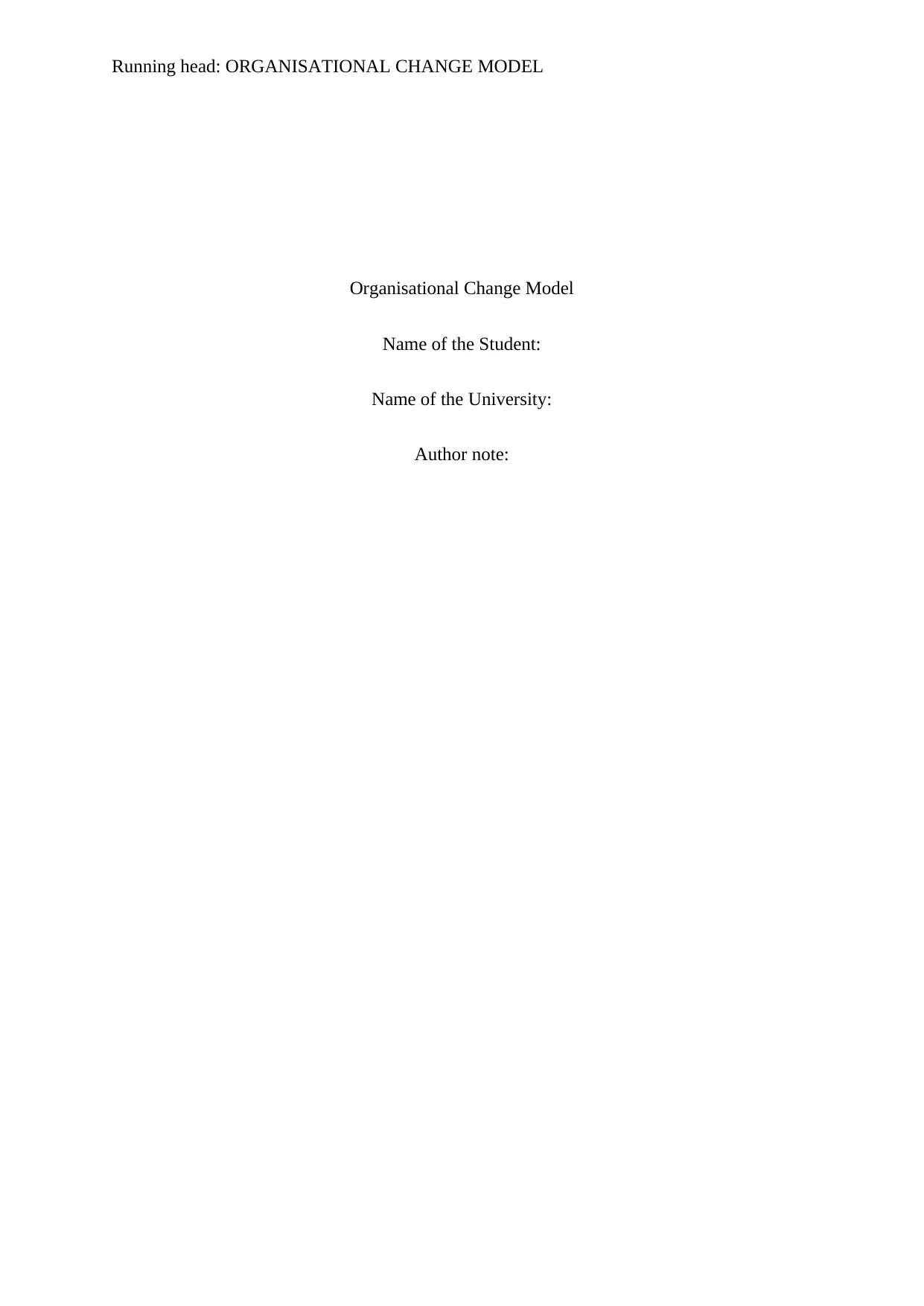
Running head: ORGANISATIONAL CHANGE MODEL
Organisational Change Model
Name of the Student:
Name of the University:
Author note:
Organisational Change Model
Name of the Student:
Name of the University:
Author note:
Secure Best Marks with AI Grader
Need help grading? Try our AI Grader for instant feedback on your assignments.
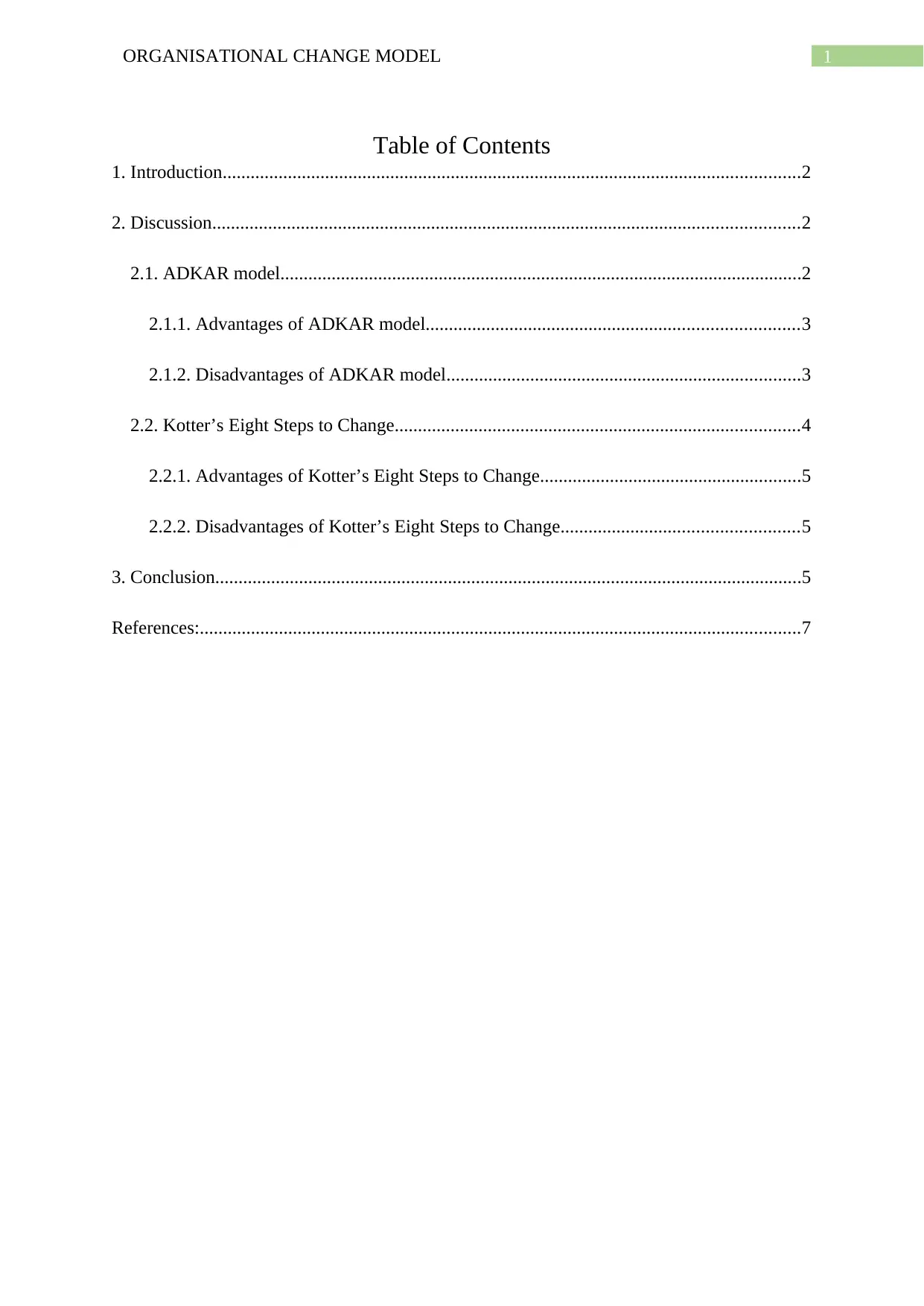
1ORGANISATIONAL CHANGE MODEL
Table of Contents
1. Introduction............................................................................................................................2
2. Discussion..............................................................................................................................2
2.1. ADKAR model................................................................................................................2
2.1.1. Advantages of ADKAR model................................................................................3
2.1.2. Disadvantages of ADKAR model............................................................................3
2.2. Kotter’s Eight Steps to Change.......................................................................................4
2.2.1. Advantages of Kotter’s Eight Steps to Change........................................................5
2.2.2. Disadvantages of Kotter’s Eight Steps to Change...................................................5
3. Conclusion..............................................................................................................................5
References:.................................................................................................................................7
Table of Contents
1. Introduction............................................................................................................................2
2. Discussion..............................................................................................................................2
2.1. ADKAR model................................................................................................................2
2.1.1. Advantages of ADKAR model................................................................................3
2.1.2. Disadvantages of ADKAR model............................................................................3
2.2. Kotter’s Eight Steps to Change.......................................................................................4
2.2.1. Advantages of Kotter’s Eight Steps to Change........................................................5
2.2.2. Disadvantages of Kotter’s Eight Steps to Change...................................................5
3. Conclusion..............................................................................................................................5
References:.................................................................................................................................7
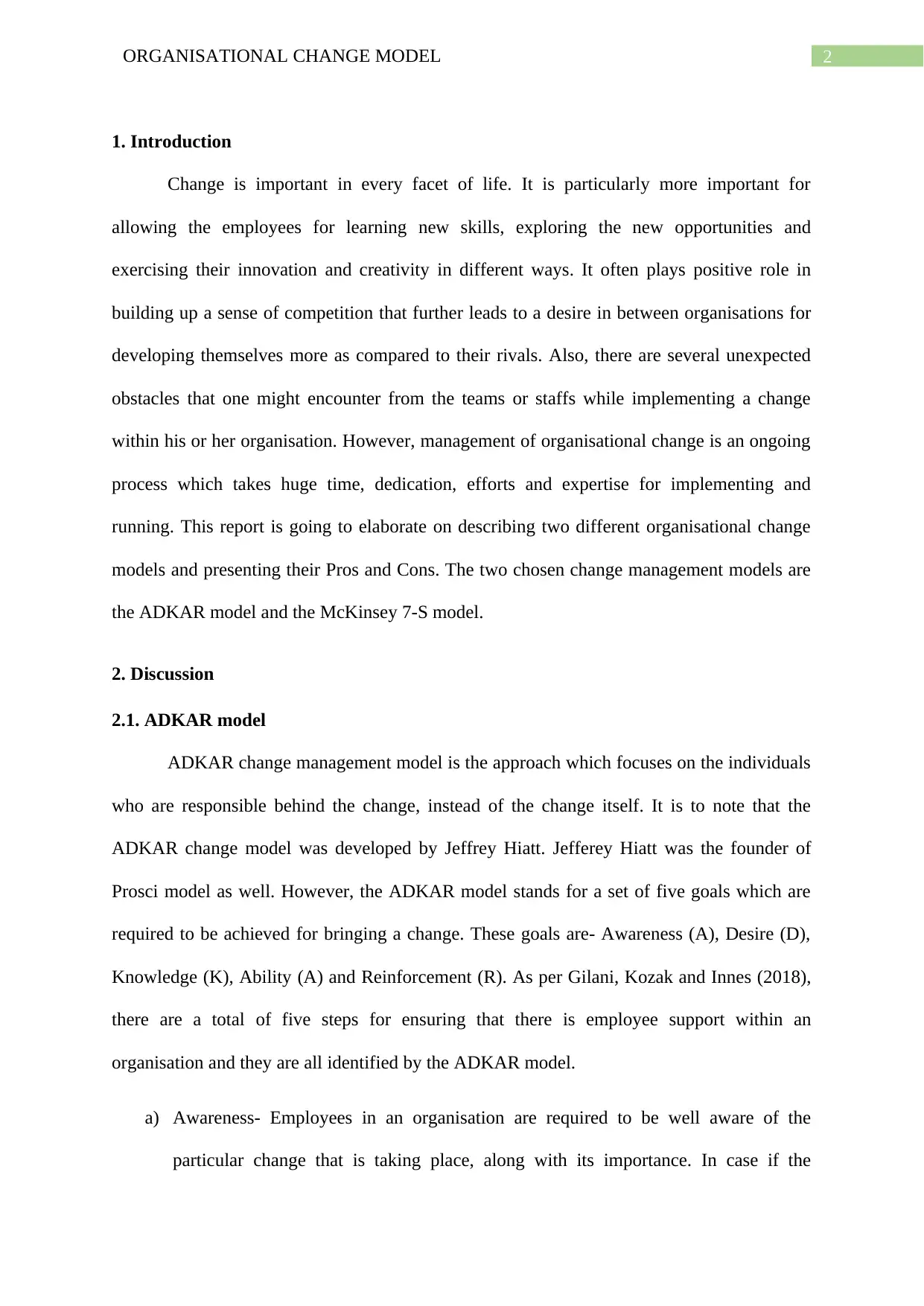
2ORGANISATIONAL CHANGE MODEL
1. Introduction
Change is important in every facet of life. It is particularly more important for
allowing the employees for learning new skills, exploring the new opportunities and
exercising their innovation and creativity in different ways. It often plays positive role in
building up a sense of competition that further leads to a desire in between organisations for
developing themselves more as compared to their rivals. Also, there are several unexpected
obstacles that one might encounter from the teams or staffs while implementing a change
within his or her organisation. However, management of organisational change is an ongoing
process which takes huge time, dedication, efforts and expertise for implementing and
running. This report is going to elaborate on describing two different organisational change
models and presenting their Pros and Cons. The two chosen change management models are
the ADKAR model and the McKinsey 7-S model.
2. Discussion
2.1. ADKAR model
ADKAR change management model is the approach which focuses on the individuals
who are responsible behind the change, instead of the change itself. It is to note that the
ADKAR change model was developed by Jeffrey Hiatt. Jefferey Hiatt was the founder of
Prosci model as well. However, the ADKAR model stands for a set of five goals which are
required to be achieved for bringing a change. These goals are- Awareness (A), Desire (D),
Knowledge (K), Ability (A) and Reinforcement (R). As per Gilani, Kozak and Innes (2018),
there are a total of five steps for ensuring that there is employee support within an
organisation and they are all identified by the ADKAR model.
a) Awareness- Employees in an organisation are required to be well aware of the
particular change that is taking place, along with its importance. In case if the
1. Introduction
Change is important in every facet of life. It is particularly more important for
allowing the employees for learning new skills, exploring the new opportunities and
exercising their innovation and creativity in different ways. It often plays positive role in
building up a sense of competition that further leads to a desire in between organisations for
developing themselves more as compared to their rivals. Also, there are several unexpected
obstacles that one might encounter from the teams or staffs while implementing a change
within his or her organisation. However, management of organisational change is an ongoing
process which takes huge time, dedication, efforts and expertise for implementing and
running. This report is going to elaborate on describing two different organisational change
models and presenting their Pros and Cons. The two chosen change management models are
the ADKAR model and the McKinsey 7-S model.
2. Discussion
2.1. ADKAR model
ADKAR change management model is the approach which focuses on the individuals
who are responsible behind the change, instead of the change itself. It is to note that the
ADKAR change model was developed by Jeffrey Hiatt. Jefferey Hiatt was the founder of
Prosci model as well. However, the ADKAR model stands for a set of five goals which are
required to be achieved for bringing a change. These goals are- Awareness (A), Desire (D),
Knowledge (K), Ability (A) and Reinforcement (R). As per Gilani, Kozak and Innes (2018),
there are a total of five steps for ensuring that there is employee support within an
organisation and they are all identified by the ADKAR model.
a) Awareness- Employees in an organisation are required to be well aware of the
particular change that is taking place, along with its importance. In case if the

3ORGANISATIONAL CHANGE MODEL
employees do not know that, they could lose the direction and motivation within the
very strategy (Karambelkar & Bhattacharya, 2017). Managers and leaders have a
very important role to play in this process in order to ensure that the employees are
completely aware of each and every elements of the change process.
b) Desire- According to Jeffrey Hiatt, supports for the strategy of change are required to
come naturally from the employees. Instead of forcing the very organisational change
upon the employees, the employees should be included in developing the vision and
the project. This would ensure that the employees are supporting the final result.
c) Knowledge- Change would bring a significant change in the skills and routines of the
employees and the overall organisational change (Lawrence & Frater, 2017).
Therefore, all the employees would be supported in their development and
acquisition of the skills.
d) Ability- Knowledge should be developed and this can take place only when the
individuals have all the required ability.
e) Reinforcement- The rewards and change process for the employees who are changing
their processes should be reinforced after the change take place. It would ensure that
employees are resisting the desire of slipping back into their old habits.
2.1.1. Advantages of ADKAR model
a) It provides a clear management checklist for managing change
b) It helps by encapsulated the process or business as well as the individual dimension of
the change
2.1.2. Disadvantages of ADKAR model
a) It misses out on the role that the principles and leadership of programme management
play for creating clarity and providing a direction to the change
b) Lack in evaluation
employees do not know that, they could lose the direction and motivation within the
very strategy (Karambelkar & Bhattacharya, 2017). Managers and leaders have a
very important role to play in this process in order to ensure that the employees are
completely aware of each and every elements of the change process.
b) Desire- According to Jeffrey Hiatt, supports for the strategy of change are required to
come naturally from the employees. Instead of forcing the very organisational change
upon the employees, the employees should be included in developing the vision and
the project. This would ensure that the employees are supporting the final result.
c) Knowledge- Change would bring a significant change in the skills and routines of the
employees and the overall organisational change (Lawrence & Frater, 2017).
Therefore, all the employees would be supported in their development and
acquisition of the skills.
d) Ability- Knowledge should be developed and this can take place only when the
individuals have all the required ability.
e) Reinforcement- The rewards and change process for the employees who are changing
their processes should be reinforced after the change take place. It would ensure that
employees are resisting the desire of slipping back into their old habits.
2.1.1. Advantages of ADKAR model
a) It provides a clear management checklist for managing change
b) It helps by encapsulated the process or business as well as the individual dimension of
the change
2.1.2. Disadvantages of ADKAR model
a) It misses out on the role that the principles and leadership of programme management
play for creating clarity and providing a direction to the change
b) Lack in evaluation
Secure Best Marks with AI Grader
Need help grading? Try our AI Grader for instant feedback on your assignments.
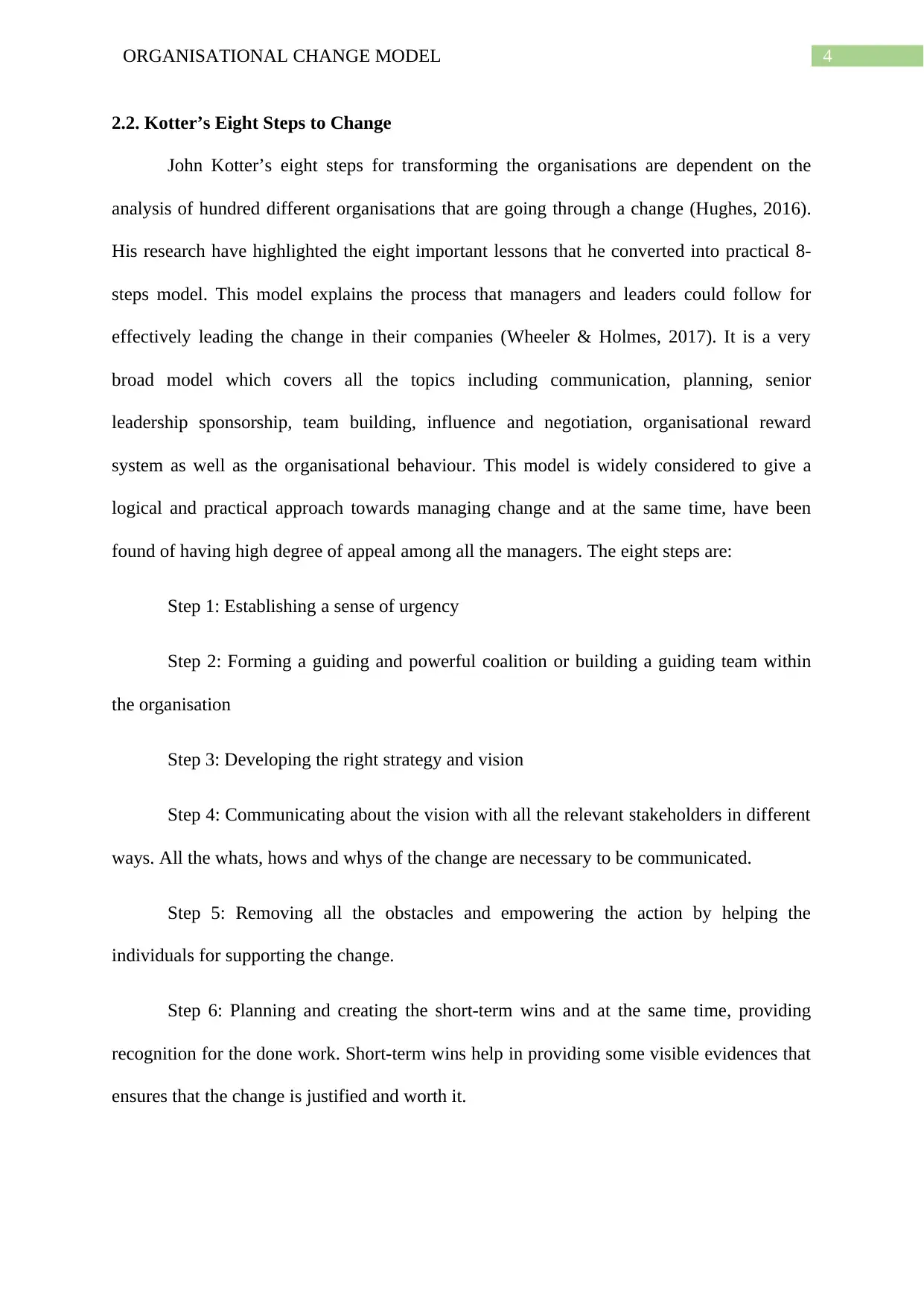
4ORGANISATIONAL CHANGE MODEL
2.2. Kotter’s Eight Steps to Change
John Kotter’s eight steps for transforming the organisations are dependent on the
analysis of hundred different organisations that are going through a change (Hughes, 2016).
His research have highlighted the eight important lessons that he converted into practical 8-
steps model. This model explains the process that managers and leaders could follow for
effectively leading the change in their companies (Wheeler & Holmes, 2017). It is a very
broad model which covers all the topics including communication, planning, senior
leadership sponsorship, team building, influence and negotiation, organisational reward
system as well as the organisational behaviour. This model is widely considered to give a
logical and practical approach towards managing change and at the same time, have been
found of having high degree of appeal among all the managers. The eight steps are:
Step 1: Establishing a sense of urgency
Step 2: Forming a guiding and powerful coalition or building a guiding team within
the organisation
Step 3: Developing the right strategy and vision
Step 4: Communicating about the vision with all the relevant stakeholders in different
ways. All the whats, hows and whys of the change are necessary to be communicated.
Step 5: Removing all the obstacles and empowering the action by helping the
individuals for supporting the change.
Step 6: Planning and creating the short-term wins and at the same time, providing
recognition for the done work. Short-term wins help in providing some visible evidences that
ensures that the change is justified and worth it.
2.2. Kotter’s Eight Steps to Change
John Kotter’s eight steps for transforming the organisations are dependent on the
analysis of hundred different organisations that are going through a change (Hughes, 2016).
His research have highlighted the eight important lessons that he converted into practical 8-
steps model. This model explains the process that managers and leaders could follow for
effectively leading the change in their companies (Wheeler & Holmes, 2017). It is a very
broad model which covers all the topics including communication, planning, senior
leadership sponsorship, team building, influence and negotiation, organisational reward
system as well as the organisational behaviour. This model is widely considered to give a
logical and practical approach towards managing change and at the same time, have been
found of having high degree of appeal among all the managers. The eight steps are:
Step 1: Establishing a sense of urgency
Step 2: Forming a guiding and powerful coalition or building a guiding team within
the organisation
Step 3: Developing the right strategy and vision
Step 4: Communicating about the vision with all the relevant stakeholders in different
ways. All the whats, hows and whys of the change are necessary to be communicated.
Step 5: Removing all the obstacles and empowering the action by helping the
individuals for supporting the change.
Step 6: Planning and creating the short-term wins and at the same time, providing
recognition for the done work. Short-term wins help in providing some visible evidences that
ensures that the change is justified and worth it.
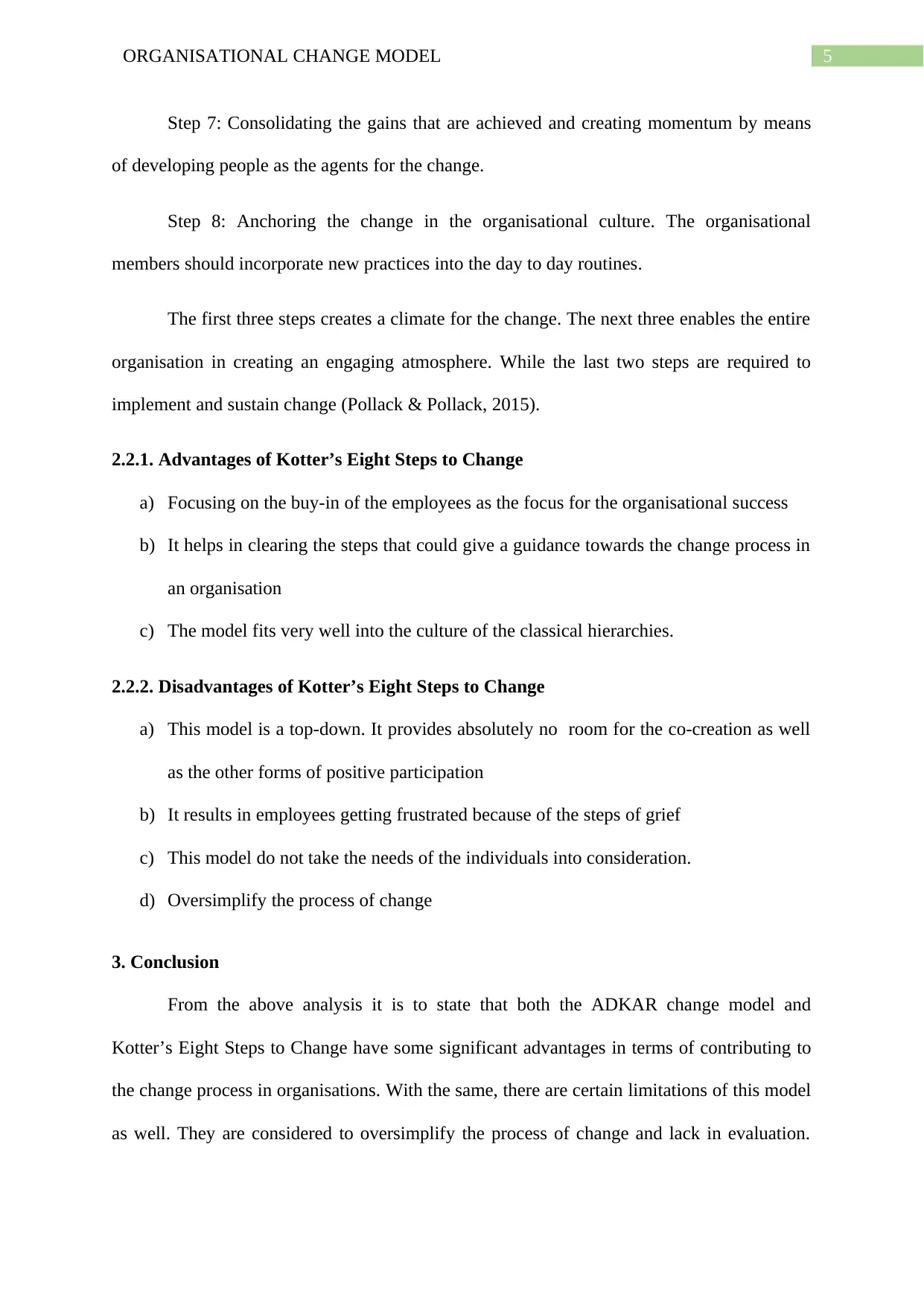
5ORGANISATIONAL CHANGE MODEL
Step 7: Consolidating the gains that are achieved and creating momentum by means
of developing people as the agents for the change.
Step 8: Anchoring the change in the organisational culture. The organisational
members should incorporate new practices into the day to day routines.
The first three steps creates a climate for the change. The next three enables the entire
organisation in creating an engaging atmosphere. While the last two steps are required to
implement and sustain change (Pollack & Pollack, 2015).
2.2.1. Advantages of Kotter’s Eight Steps to Change
a) Focusing on the buy-in of the employees as the focus for the organisational success
b) It helps in clearing the steps that could give a guidance towards the change process in
an organisation
c) The model fits very well into the culture of the classical hierarchies.
2.2.2. Disadvantages of Kotter’s Eight Steps to Change
a) This model is a top-down. It provides absolutely no room for the co-creation as well
as the other forms of positive participation
b) It results in employees getting frustrated because of the steps of grief
c) This model do not take the needs of the individuals into consideration.
d) Oversimplify the process of change
3. Conclusion
From the above analysis it is to state that both the ADKAR change model and
Kotter’s Eight Steps to Change have some significant advantages in terms of contributing to
the change process in organisations. With the same, there are certain limitations of this model
as well. They are considered to oversimplify the process of change and lack in evaluation.
Step 7: Consolidating the gains that are achieved and creating momentum by means
of developing people as the agents for the change.
Step 8: Anchoring the change in the organisational culture. The organisational
members should incorporate new practices into the day to day routines.
The first three steps creates a climate for the change. The next three enables the entire
organisation in creating an engaging atmosphere. While the last two steps are required to
implement and sustain change (Pollack & Pollack, 2015).
2.2.1. Advantages of Kotter’s Eight Steps to Change
a) Focusing on the buy-in of the employees as the focus for the organisational success
b) It helps in clearing the steps that could give a guidance towards the change process in
an organisation
c) The model fits very well into the culture of the classical hierarchies.
2.2.2. Disadvantages of Kotter’s Eight Steps to Change
a) This model is a top-down. It provides absolutely no room for the co-creation as well
as the other forms of positive participation
b) It results in employees getting frustrated because of the steps of grief
c) This model do not take the needs of the individuals into consideration.
d) Oversimplify the process of change
3. Conclusion
From the above analysis it is to state that both the ADKAR change model and
Kotter’s Eight Steps to Change have some significant advantages in terms of contributing to
the change process in organisations. With the same, there are certain limitations of this model
as well. They are considered to oversimplify the process of change and lack in evaluation.

6ORGANISATIONAL CHANGE MODEL
Also, they do not take ample of amount of the often turbulent business and environment
context in which the organisational change takes place.
Also, they do not take ample of amount of the often turbulent business and environment
context in which the organisational change takes place.
Paraphrase This Document
Need a fresh take? Get an instant paraphrase of this document with our AI Paraphraser

7ORGANISATIONAL CHANGE MODEL
References:
Gilani, H. R., Kozak, R. A., & Innes, J. L. (2018). A Change Management Model for the
Adoption of Chain of Custody Certification in the British Columbia Value-added
Wood Products Sector. Journal of Change Management, 18(3), 240-256. Available at
DOI: 10.1080/14697017.2017.1349163
Hughes, M. (2016). Leading changes: Why transformation explanations
fail. Leadership, 12(4), 449-469. Available at DOI: 10.1177/1742715015571393
Karambelkar, M., & Bhattacharya, S. (2017). Onboarding is a change: Applying change
management model ADKAR to onboarding. Human Resource Management
International Digest, 25(7), 5-8. Available at DOI: 10.1108/HRMID-04-2017-0073
Lawrence, G. A., & Frater, T. G. (2017). Change management in healthcare: managing
paradigmatic change in the Australian National Cervical Screening Programme. New
Zealand Journal of Medical Laboratory Science, 71(2), 31. Available at:
https://www.thefreelibrary.com/Change+management+in+healthcare
%3A+managing+paradigmatic+change+in+the+...-a0507657826
Pollack, J., & Pollack, R. (2015). Using Kotter’s eight stage process to manage an
organisational change program: Presentation and practice. Systemic Practice and
Action Research, 28(1), 51-66. Available at DOI: 10.1007/s11213-014-9317-0
Wheeler, T. R., & Holmes, K. L. (2017). Rapid transformation of two libraries using Kotter’s
Eight Steps of Change. Journal of the Medical Library Association: JMLA, 105(3),
276. Available at DOI: dx.doi.org/10.5195/jmla.2017.97
References:
Gilani, H. R., Kozak, R. A., & Innes, J. L. (2018). A Change Management Model for the
Adoption of Chain of Custody Certification in the British Columbia Value-added
Wood Products Sector. Journal of Change Management, 18(3), 240-256. Available at
DOI: 10.1080/14697017.2017.1349163
Hughes, M. (2016). Leading changes: Why transformation explanations
fail. Leadership, 12(4), 449-469. Available at DOI: 10.1177/1742715015571393
Karambelkar, M., & Bhattacharya, S. (2017). Onboarding is a change: Applying change
management model ADKAR to onboarding. Human Resource Management
International Digest, 25(7), 5-8. Available at DOI: 10.1108/HRMID-04-2017-0073
Lawrence, G. A., & Frater, T. G. (2017). Change management in healthcare: managing
paradigmatic change in the Australian National Cervical Screening Programme. New
Zealand Journal of Medical Laboratory Science, 71(2), 31. Available at:
https://www.thefreelibrary.com/Change+management+in+healthcare
%3A+managing+paradigmatic+change+in+the+...-a0507657826
Pollack, J., & Pollack, R. (2015). Using Kotter’s eight stage process to manage an
organisational change program: Presentation and practice. Systemic Practice and
Action Research, 28(1), 51-66. Available at DOI: 10.1007/s11213-014-9317-0
Wheeler, T. R., & Holmes, K. L. (2017). Rapid transformation of two libraries using Kotter’s
Eight Steps of Change. Journal of the Medical Library Association: JMLA, 105(3),
276. Available at DOI: dx.doi.org/10.5195/jmla.2017.97
1 out of 8
Related Documents
Your All-in-One AI-Powered Toolkit for Academic Success.
+13062052269
info@desklib.com
Available 24*7 on WhatsApp / Email
![[object Object]](/_next/static/media/star-bottom.7253800d.svg)
Unlock your academic potential
© 2024 | Zucol Services PVT LTD | All rights reserved.





